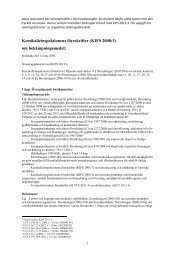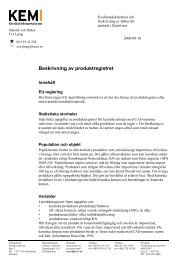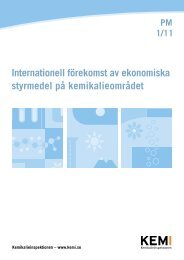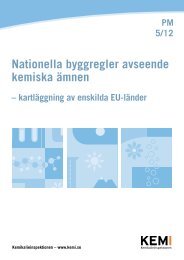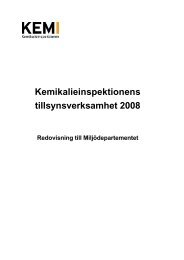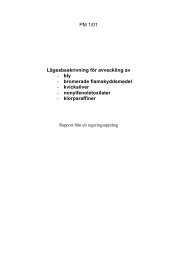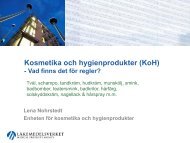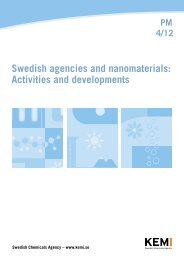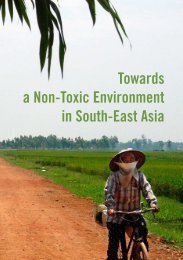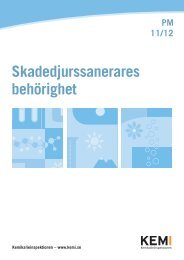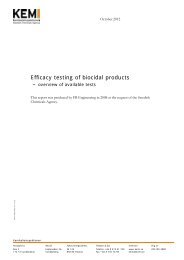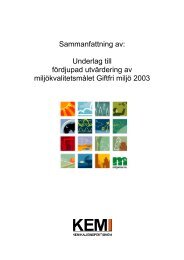KemI Rapport 3/06. - Kemikalieinspektionen
KemI Rapport 3/06. - Kemikalieinspektionen
KemI Rapport 3/06. - Kemikalieinspektionen
You also want an ePaper? Increase the reach of your titles
YUMPU automatically turns print PDFs into web optimized ePapers that Google loves.
HBCDDThe practical and economic consequences of a national ban on the manufacture and importof HBCDD in the applications of expanded polystyrene (EPS), extruded polystyrene (XPS)and textile materials are considered to be negligible as this application has either ceased oris very small-scale in Sweden. Less than one per cent of the EPS manufactured in Swedenis flame-retarded. Current Swedish fire protection requirements can be met without theaddition of flame retardant substance. If the fire protection requirements governing, forexample, sandwich panels were to be tightened up, EPS would probably need to bereplaced with other materials, for example mineral wool.There is no basis for being able to quantify the costs for the enterprises that importelectronic products whose housings and casings are made from HIPS plastic that is flameretardedwith HBCDD. A practical consequence might be that some articles within thisproduct group would disappear from the Swedish market. This applies particularly if thetime for the entry into force is short. Another likely consequence is a return/changeover todecaBDE if continued use of decaBDE is authorised in accordance with the RoHSDirective.TBBPAA comprehensive national ban would most probably stop the manufacture and import ofmost electronic products, which would have very considerable adverse practical andeconomic consequences for society. The consequences are due to the fact that it would notbe possible to use epoxy resin that is flame-retarded with TBBPA for the manufacture oflaminate in printed boards, import epoxy resin that is flame-retarded with TBBPA orimport electronic products containing such epoxy resin. The flame-retarded epoxy resin isa basic material for the manufacture of laminate for printed boards and for encapsulation ofelectronic components. More than 95 per cent of all the world’s printed boards are madefrom epoxy resin flame-retarded with TBBPA. A national ban covering this use wouldconsequently lead to considerable costs and would directly and indirectly affect tens ofthousands of jobs within the electronics industry and the part of the manufacturing industrythat is dependent on electronic products. There is also domestic manufacture of flameretardedepoxy resin. However, this article accounts for only a small proportion of therespective enterprise’s sales volume.A regulation that prevents use in which TBBPA is reactively bound in epoxy resin is not inproportion to the aim of the measure.There is no information to enable a quantification of the costs for the enterprises thatimport electronic products whose casings and housings are made from ABS plastic flameretardedwith TBBPA. A practical consequence might be that some articles within thisproduct group would disappear from the Swedish market. This applies particularly if thetime for the entry into force is short. Another likely consequence is that both Swedishmanufacturers who use ABS plastic in their manufacture and importers of electronicproducts will choose to go back/switch to using decaBDE if continued use of decaBDE isauthorised in accordance with the RoHS Directive.19



